Weight Loss Statistics By Market Size, Types, Region, Growth, Trends And Facts (2025)
Updated · Oct 20, 2025

Table of Contents
- Introduction
- Editor’s Choice
- General Statistics
- Weight Loss Market Size
- Weight Loss Consumers Statistics by Region
- By Demographics
- Weight Loss Statistics by Types
- Global Weight Loss and Obesity Management Growth
- Weight Loss Program Statistics
- Methods for Weight Loss Analyses
- Top Reasons for Losing Weight
- Conclusion
Introduction
Weight Loss Statistics: Weight loss has become a major global concern as obesity rates continue to rise and people focus more on living healthier lives. Growing awareness of the health problems linked to being overweight has increased the demand for reliable weight loss options. The weight loss industry is shifting toward healthy eating, regular workouts, and digital fitness tools. In recent years, people have preferred balanced diets and online wellness programs for staying fit and maintaining health.
Several weight loss methods offer long-lasting lifestyle changes, boosting demand for weight loss products and services, which in turn contribute significantly to the global economy. As people invest huge amounts in their health and well-being, the industry plays a crucial role in shaping healthier communities and influencing consumer spending patterns worldwide.
This article on weight loss statistics includes key trends, common approaches, and the industry’s financial growth from several different insights.
Editor’s Choice
- According to Global Newswire, the global weight loss market is estimated to reach around USD 327.8 billion by 2025, up from USD 299.1 billion in 2024.
- In the U.S., nearly 49% of adults attempt to lose weight annually, with 56.4% being women and 41.7% men.
- The United States leads the global weight loss market, holding 45% of total revenue, with obesity affecting over 42% of adults.
- One should aim for about 75 minutes of vigorous exercise or a mix of moderate and vigorous activities each week to meet health guidelines.
- The global weight loss supplements market has grown to USD 33.14 billion in 2024 and is expected to reach around USD 36.80 billion by
- According to Future Market Insights, the global weight loss and obesity management market will grow at a strong CAGR of 12.8% between 2025 and 2035.
- Globally, about 63% of people were focused on weight loss programs in 2024.
- About 46% of people have been following various weight loss methods and programs for a year or longer.
- About 22% of people have purchased supplements to help achieve their goals, while 4% opted for physical products such as exercise equipment.
- A myshortlister.com report stated that the most popular ways to lose weight include exercising (62.9%), eating smaller portions (62.9%), and adding more fruits and vegetables (50.4%) to meals.
- Around 95% of people aimed to lose weight mainly for their family members.
General Statistics
- By 2025, the global weight loss industry is projected to drive a 3% rise in health-related spending.
- In the U.S., nearly 49% of adults attempt to lose weight annually, with 56.4% being women and 41.7% men.
- Around 62.9% rely mainly on exercise and dieting for results.
- In 2024, around 95% of people aim to lose weight mainly to improve their health.
- Around 5% to 10% of body weight improves overall health, enhancing blood pressure, cholesterol balance, and blood sugar management effectively.
- The rising weight loss market shows growing demand for diets, fitness plans, supplements, and medical treatments.
- People who lose weight slowly, about 1 to 2 pounds weekly, often keep it off longer and achieve lasting, healthy results.
- The Centers for Disease Control and Prevention report stated that individuals should engage in 150 minutes of moderate aerobic exercise each week.
- Weight Loss Statistics suggest 75 minutes of intense or mixed exercise weekly for optimal physical activity.
- From 2020 to 2025, the Dietary Guidelines for Americans report that over 80% consume insufficient vegetables, fruits, and dairy.
Weight Loss Market Size
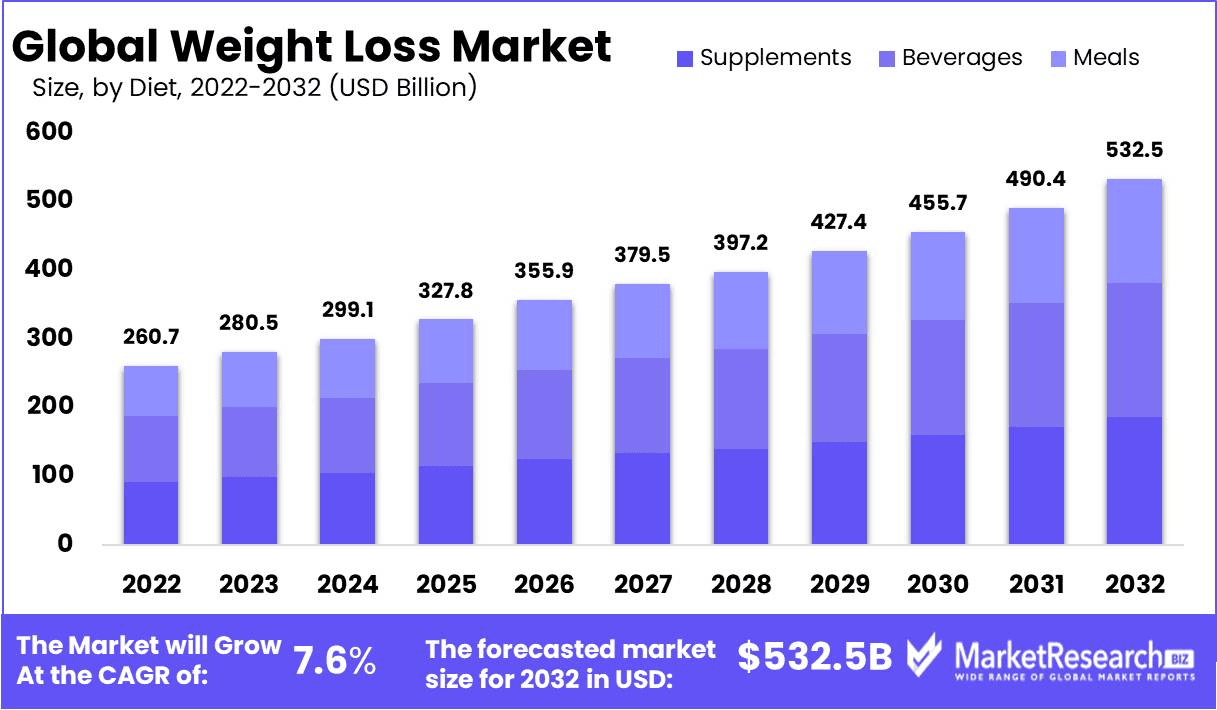
- According to Global Newswire, the global weight loss market is estimated to reach around USD 327.8 billion by 2025, up from USD 299.1 billion in 2024.
- From 2024 to 2033, the market is projected to grow at 7.6% annually on average.
- Furthermore, the weight loss market revenue is expected to reach around USD 355.9 billion by 2026, USD 379.5 billion by 2027, USD 397.2 billion by 2028, USD 427.4 billion by 2029, USD 455.7 billion by 2030, USD 490.4 billion by 2031, and USD 532.5 billion by 2032.
Weight Loss Consumers Statistics by Region
- The United States leads the global weight loss market, holding 45% of total revenue, with obesity affecting over 42% of adults.
- Americans spend an average of USD 430 per person annually on weight loss products and services.
- Europe follows as the second-largest market, contributing 25% of global revenue.
- The Asia-Pacific region is the fastest-growing, expected to expand at a 7% annual rate.
- Meanwhile, Latin America accounted for a global share of 10%, and the Middle East and Africa represented only 5% of the market.
By Demographics
- In 2024, weight loss statistics show that 56.4% of U.S. women and 41.7% of men actively tried to lose weight.
- Women continue to lead the market, making up 65% of all weight loss product consumers, especially those aged 30 to 40, driven by health concerns and social influences.
- Men aged between 25 and 40 years represented 35% of the market, showing growing awareness of fitness.
- People aged from 18 to 24 years accounted for 15%, while market distribution across age groups stood at 25 to 34 years (25%), 35 to 50 years (40%), and 50+ years (20%).
- Success rates varied by age, with only 42.7% of older adults achieving weight loss compared to 50% of adults under 40 years and 52% of middle-aged individuals.
- By race, 41.4% of Asian Americans, 48% of African Americans, 49.1% of Hispanics, and 49.4% of White Americans aimed to lose weight in 2024.
Weight Loss Statistics by Types
Exercise
- One should aim for about 75 minutes of vigorous exercise or a mix of moderate and vigorous activities each week to meet health guidelines.
- According to the World Health Organisation, not getting enough physical activity can increase the risk of death by 20% to 30%.
- In the U.S., 46.9 % of adults achieve the recommended level of aerobic exercise, but only 24.2 % combine both aerobic and resistance training successfully.
- In recent years, around 19.3% of Americans participate in sports or engage in exercise.
- Men report slightly more physical activity (20.7%) than women (18%), while Americans who do exercise spend about 30 minutes per session.
- Also, Vermont leads with a 28.5% exercise rate, and Kentucky trails at just 15.3%
Supplement Use
- According to Coherent Market Insights, the global weight loss supplements market has grown to USD 33.14 billion in 2024 and is expected to reach around USD 36.80 billion by
- Meanwhile, Precedence Research estimates the market to reach USD 37.89 billion.
- Tablets and pills will account for about 36.3% of total product share, while online sales are expected to lead distribution channels with a 53.2% share in 2025.
Physical Activity
- A JAMA Network study analysed 116 trials with 6,880 overweight or obese adults.
- It found that adding 30 minutes of aerobic exercise weekly resulted in an average 0.52 kg weight loss, followed by 0.56 cm waist reduction, and 0.37% less fat reduction.
- The research recommends at least 150 minutes of moderate-intensity exercise each week for visible health improvements.
- Similarly, MDPI’s Nutrients journal notes that aerobic training alone results in 0 to 2 kg weight loss, especially at higher volumes, and is most effective when combined with diet.
- WHO further reports that 31% of adults and 80% of adolescents are inactive, aiming for a 10% reduction by 2025.
Diet
- According to the International Food Information Council, 40% of Americans diet mainly to lose weight, while 30% do so to prevent weight gain.
- About 58% snack at least once daily, and 25% admit to frequent snacking.
- The same report notes that 1 in 10 dieters uses calorie counting for weight management.
- In 2024, nearly 80% of people use various diets and apps to manage weight and eating habits.
- A report published by the CDC shows that around 17.1% of adults were dieting in 2024, and 30% actively pursued weight loss by 2025.
Global Weight Loss and Obesity Management Growth
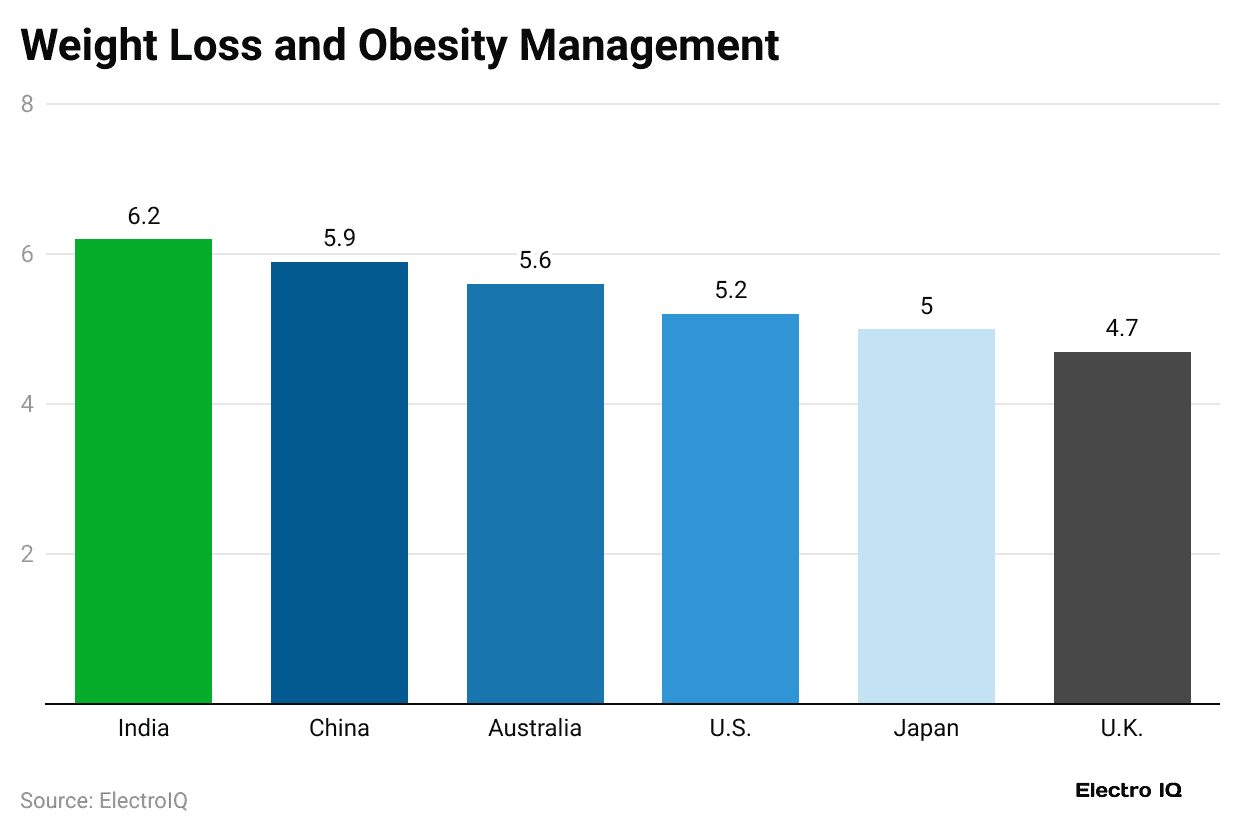
- According to Future Market Insights, the global weight loss and obesity management market will grow at a strong CAGR of 12.8% between 2025 and 2035.
- Among leading countries, India shows the fastest growth at 6.2%, followed by China (5.9%), Australia (5.6%), and the United States (5.2%).
- Meanwhile, Japan records a 5.0% growth rate, and the United Kingdom follows at 4.7%.
Weight Loss Program Statistics
By Current Weight Goals
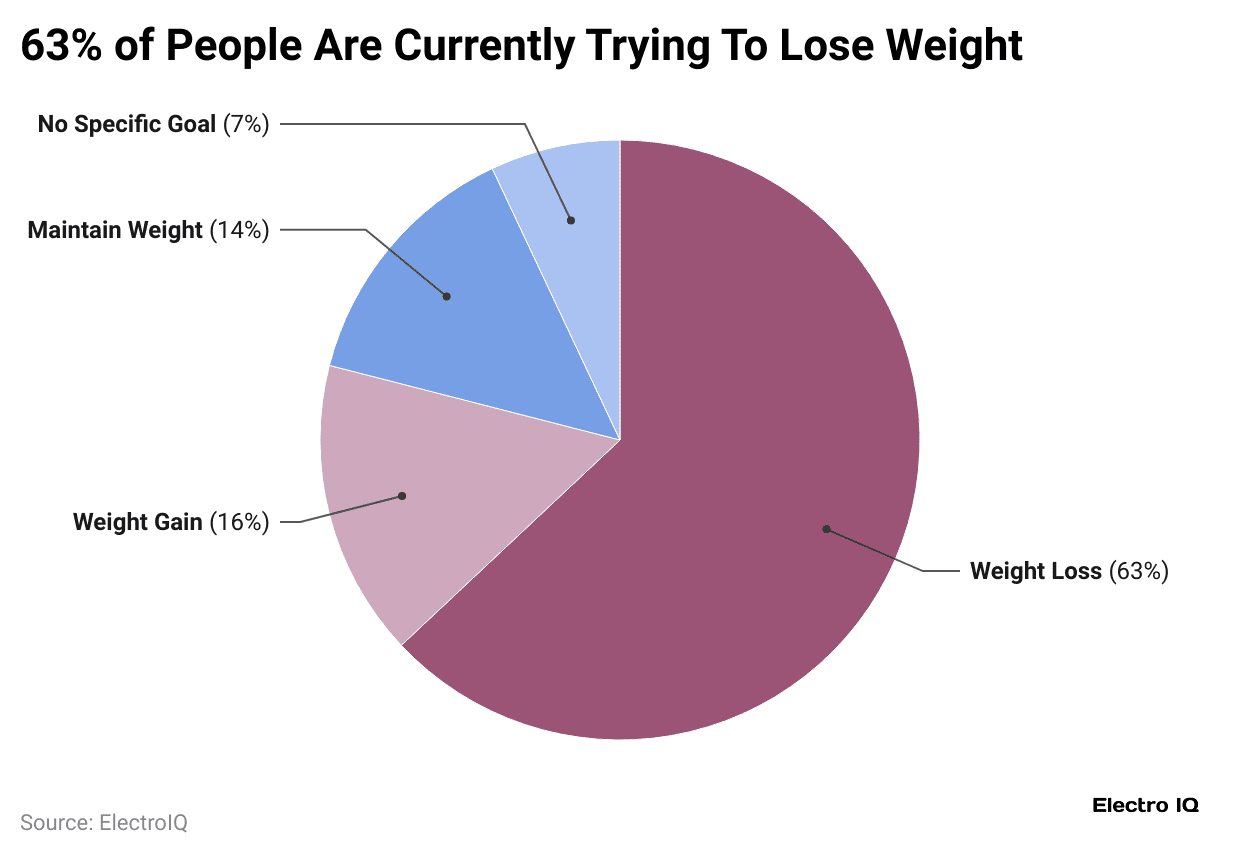
- Globally, about 63% of people were focused on weight loss programs in 2024.
- Followed by aimed to gain weight (16%), maintain weight (14%), and no specific goal (7%).
By Duration of Weight Loss Efforts
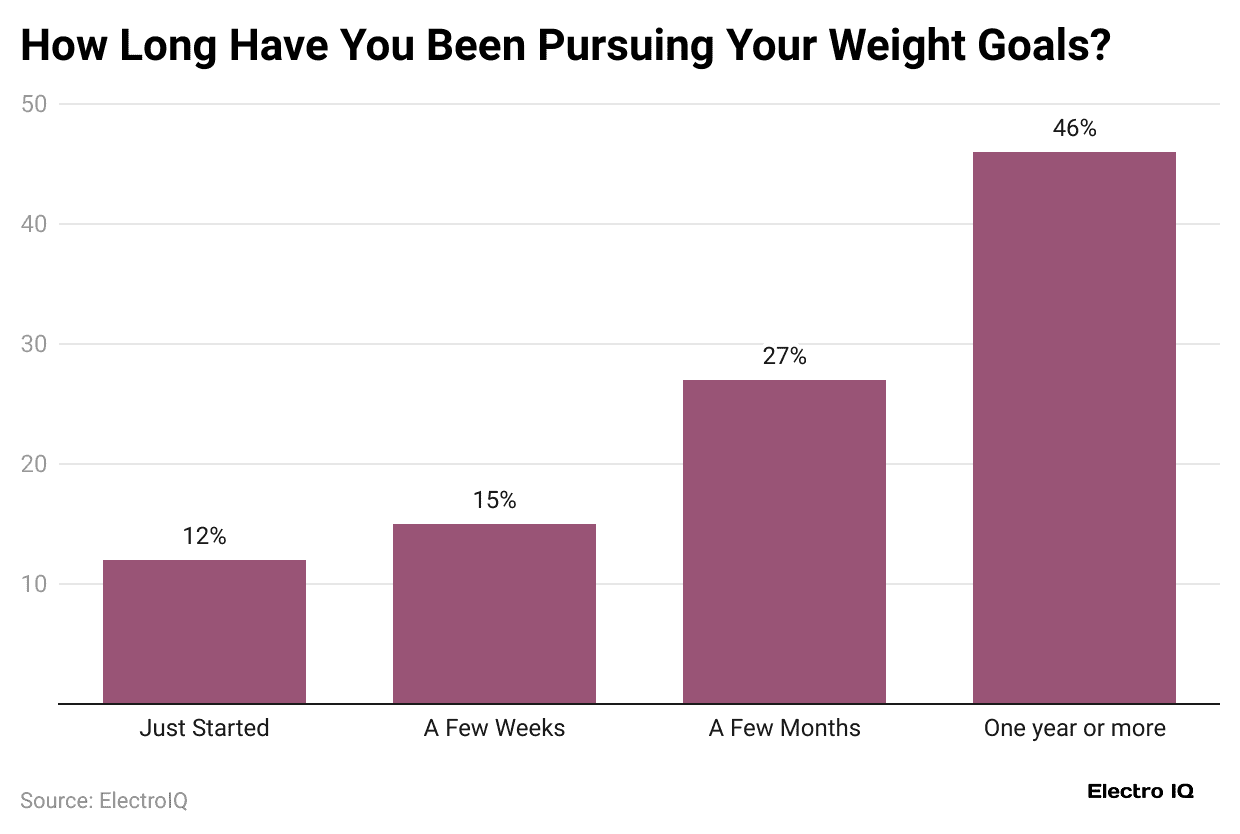
- The graph shows that in 2024, about 46% of people have been following various weight loss methods and programs for a year or longer.
- Another 27% began dieting a few months ago, while 15% already started a few weeks earlier, and 12% have only just begun their weight loss journey.
By Frequency of Calorie Counting
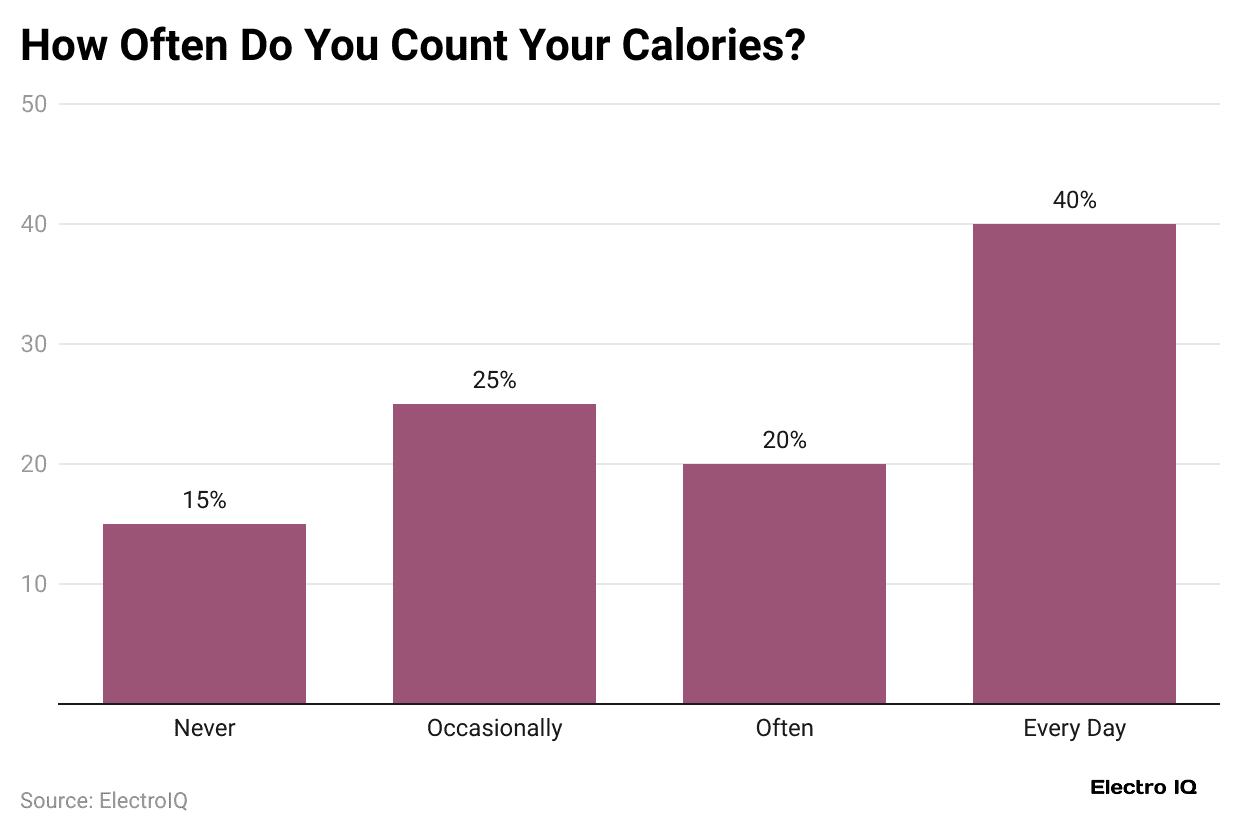
- In 2024, one in ten people on a diet uses calorie counting to manage weight.
- Globally, about 85% track what they eat in some way, followed by 40% count calories regularly, 20% do it often, 25% only occasionally, and 15% never track.
By Use of Weight Loss Products
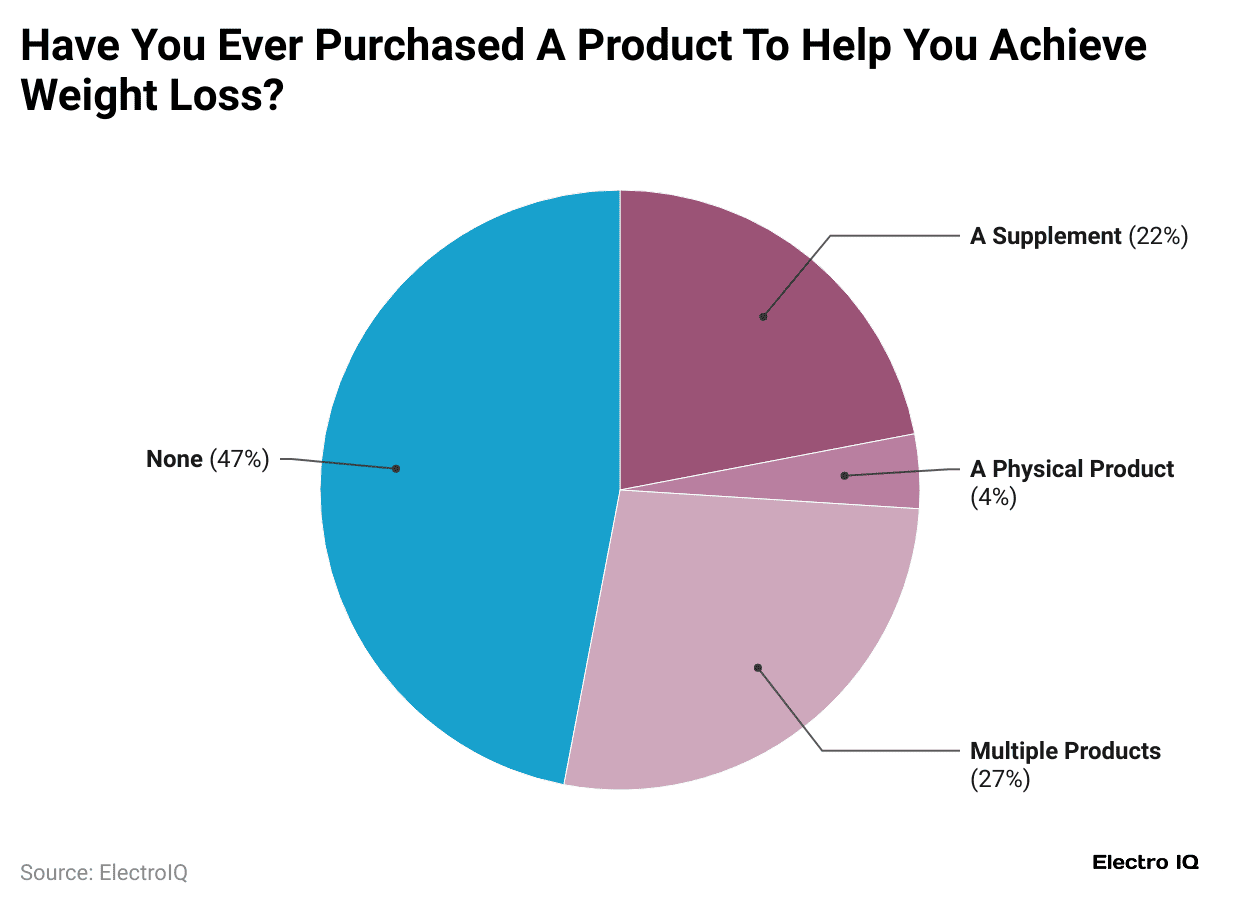
- About 22% of people have purchased supplements to help achieve their goals, while 4% opted for physical products such as exercise equipment.
- Around 27% have tried multiple products, showing a combination of approaches for better results.
- Interestingly, 47% of respondents reported they haven’t purchased any weight loss product.
Methods for Weight Loss Analyses
- A myshortlister.com report stated that the most popular ways to lose weight include exercising (62.9%), eating smaller portions (62.9%), and adding more fruits and vegetables (50.4%) to meals.
- On average, women need about 1,500 calories per day to lose weight, while men require around 2,000 calories.
- Drinking water before meals can boost metabolism by 30%, and cutting carbs helps reduce appetite.
- A high-protein diet supports faster metabolism and reduces food cravings.
- Avoiding sugary drinks like sodas and chocolate milk lowers obesity risk.
- Muscle Milk remains the top-selling U.S. weight management brand.
- About 37% of Americans use step counter apps, and 44% plan to exercise more.
- Gastric bypass surgery costs roughly USD 23,000 and is the most common procedure.
- During the pandemic, 47% cooked more at home, and fitness habits rose by 88%.
Top Reasons for Losing Weight
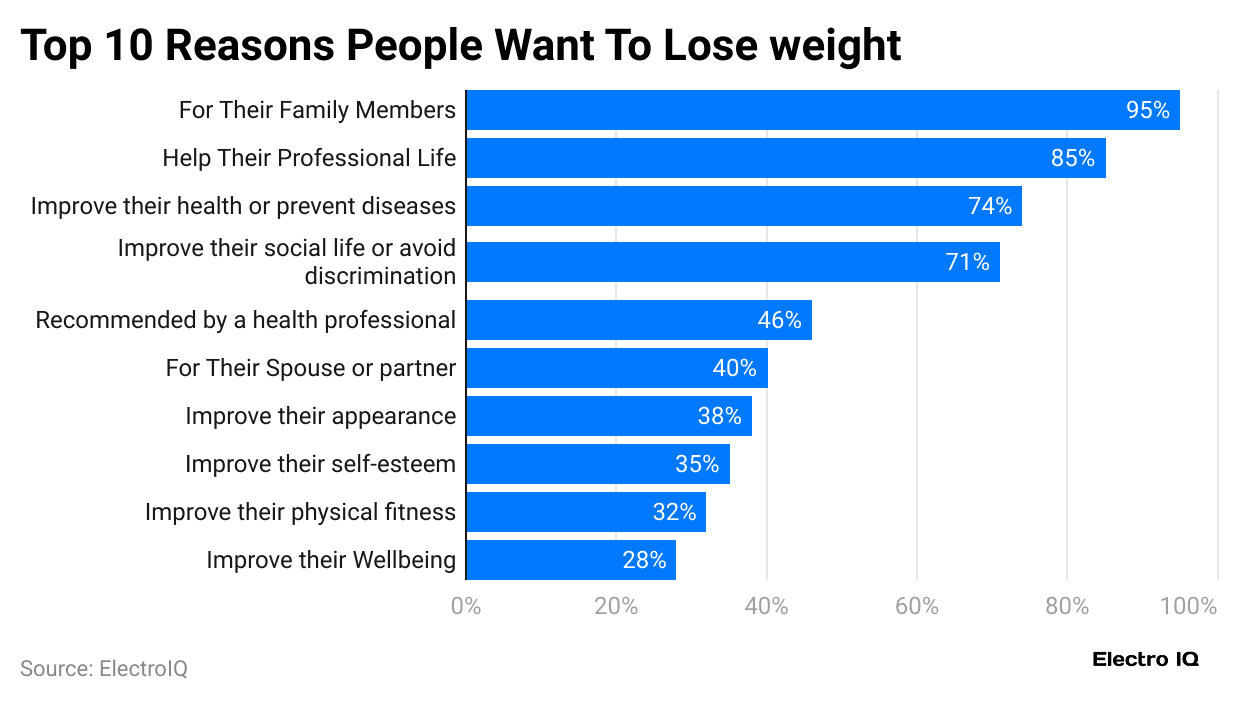
- The above survey reveals that 95% of people aimed to lose weight mainly for their family members.
- Around 85% say they want to improve their professional life, while 74% focus on better health or disease prevention.
- Additionally, 71% want to enhance their social life or avoid discrimination.
- Recommendations from health professionals motivate 46%, whereas 40% do it for their partner or spouse.
- Improving appearance (38%), self-esteem (35%), and physical fitness (32%) also play major roles.
- Lastly, 28% of respondents aim to lose weight to improve their overall well-being.
Conclusion
After completing the article on Weight Loss Statistics, it can be concluded that weight loss is not about burning fat. Still, the process helps in promoting long-term health solutions that align with modern consumer values and sustainability. In recent years, the weight loss industry has become a dynamic and rapidly evolving industry, driven by increasing global concerns about health, obesity, and several chronic diseases.
With the growing focus on overall health, people are moving away from short-term diets and choosing lasting lifestyle habits that support long-term wellness and boost self-confidence.
Sources
FAQ.
Weight gain occurs when calorie intake exceeds calorie burn due to a poor diet and inactivity.
Balanced diet, regular exercise, hydration, portion control, and proper sleep are the most effective weight loss methods.
An individual can safely lose around 2 to 4 kilograms per month through a balanced diet and exercise.
Yes, age slows metabolism, making weight loss harder, but regular exercise and healthy eating help.
Weight loss supplements can be safe if approved and used correctly, but medical advice is essential.

Maitrayee Dey has a background in Electrical Engineering and has worked in various technical roles before transitioning to writing. Specializing in technology and Artificial Intelligence, she has served as an Academic Research Analyst and Freelance Writer, particularly focusing on education and healthcare in Australia. Maitrayee's lifelong passions for writing and painting led her to pursue a full-time writing career. She is also the creator of a cooking YouTube channel, where she shares her culinary adventures. At Smartphone Thoughts, Maitrayee brings her expertise in technology to provide in-depth smartphone reviews and app-related statistics, making complex topics easy to understand for all readers.










